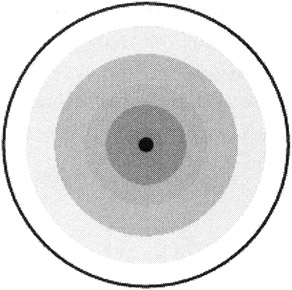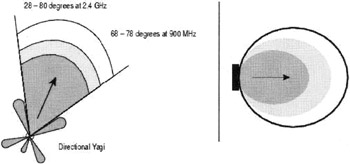Antenna Types
|
| < Day Day Up > |
|
There are many different types of antennae, but for most WLAN designs, you only need to consider two:
One is the omni-directional antenna, which has a 360 degree coverage pattern on a horizontal plane. This type of antenna is ideal for square or square-like coverage areas (such as found in most office buildings), because its coverage pattern is configured in both horizontal plane and torus-shaped (i.e. doughnut-shaped) forms. Included within the omni-directional antenna group are the plane antenna and the dipole antenna.
The other is the directional antenna, which concentrates the coverage pattern in one direction, producing an almost conical-shaped coverage pattern (similar to that of a flashlight). With a directional antenna, the directionality is specified by the angle of the beam width. Typical beam width angles are from 90 degrees to as little as 20 degrees. A directed beam is ideal for elongated areas (such as warehouse aisles), corners and outdoor point-to-point applications since they allow for a longer but narrower coverage pattern. Included in the directional antenna group are patch antennae for wider directed beam coverage, and panel antennae and yagi antennae for narrow beam coverage.

Figure 19.2: Omni-directional antenna coverage pattern.

Figure 19.3: Examples of the beam coverage of a yagi antenna (left) and a patch antenna (right).
In the early days of mobile radio and other wireless systems, the base station antenna radiation pattern was determined primarily by the required gain to ensure reliable communication over the required coverage area, and usually had a simple omni-directional pattern. The evolution of modern wireless communications very much involves the story of how electrical engineers were able to figure out ways to precisely control the antenna radiation pattern, in terms of envelope shape and electrical tilt.
The relatively high frequencies of the WLAN bands allow for a more directional or "beam" form of transmission, which is reflected in some antenna designs. An omnidirectional antenna's horizontal radiation pattern can have some directivity added in the vertical direction to increase the power, sensitivity, or "gain" (such as changing the "down-tilt" of the signal). Simple changes in an antenna can shape the radiation such that the "doughnut is flattened" and the outer-most energy can be focused, resulting in a decibel gain in the radiated energy along the horizontal plane.
| Note | In a sense, "gain" can also be considered as "loss," since increasing the gain of an antenna results in a smaller effective angle of use. |
This ability to provide a more directional or beam form of transmission means that WLAN users need not consciously "point" their mobile computing device in a particular direction. It is also why antenna placement is so important.
Yagi antennae have tremendous gain and directivity, since they can direct almost their entire signal in just one direction, instead of dispersing all of the energy around a 360-degree partial sphere.
Panel or sector antennae allow a cell to be partitioned into sectors, each with different frequencies (sectors that overlap cannot operate at the same time on the same frequency and polarization).
|
| < Day Day Up > |
|
EAN: 2147483647
Pages: 273